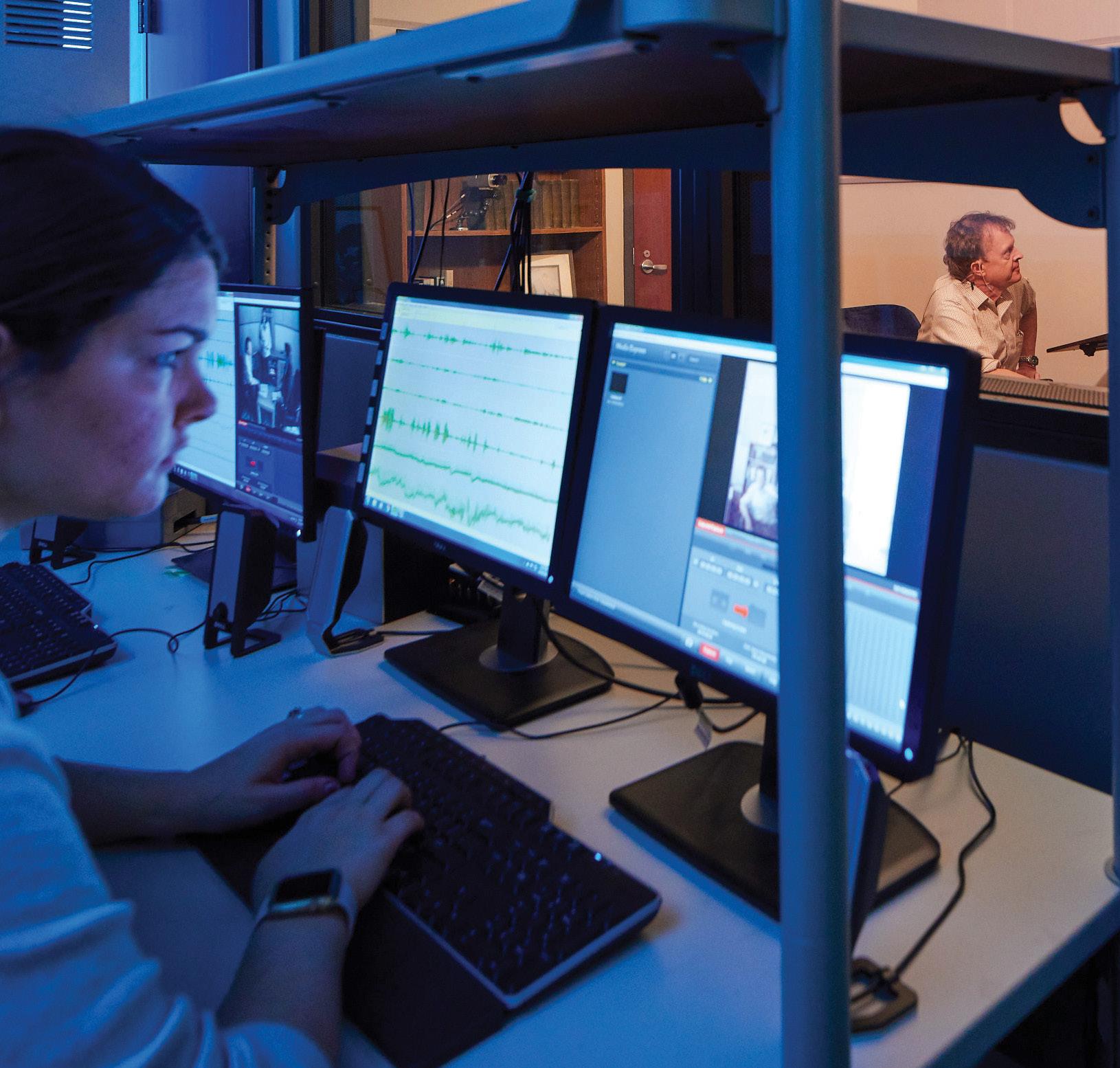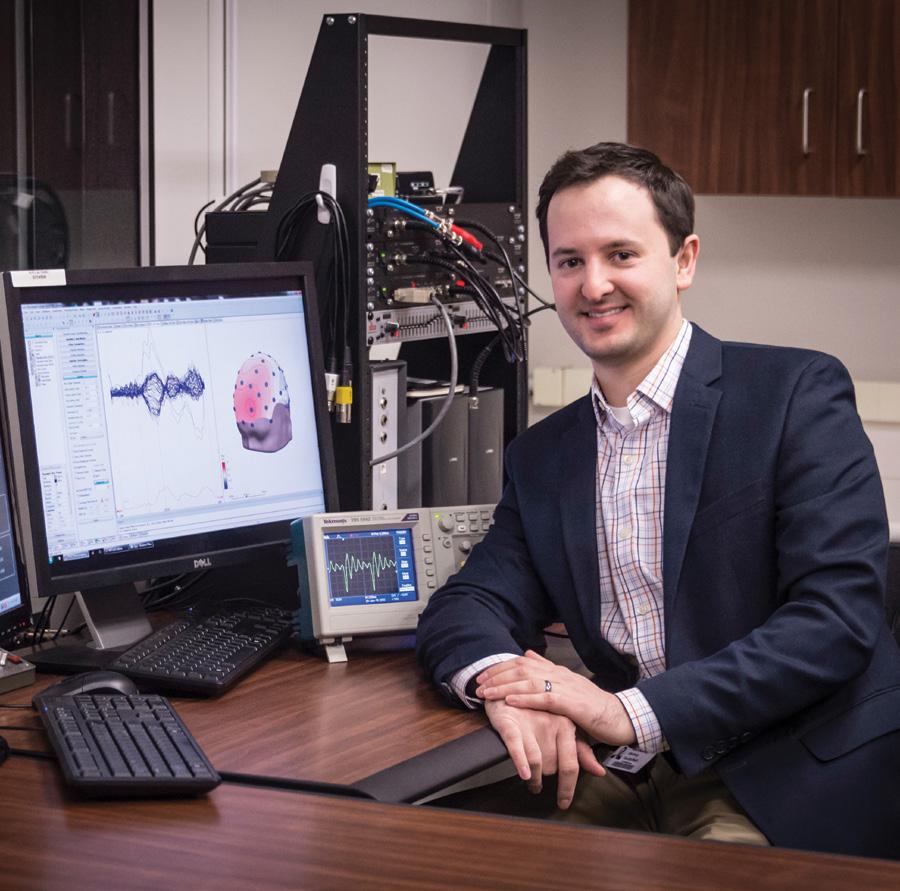
3 minute read
Social Interaction Laboratory
Eugene H. Buder, PhD is associate professor in the School of Communication Sciences and Disorders and has been a member of the faculty since 1996. His undergraduate degree from Harvard College combined the fields of Psychology and Linguistics to compare speech and music as modes of communication. He pursued these interests at the University of Alberta by studying rhythmic and melodic aspects of conversational communication, earning an MA degree in Education and Anthropology. He earned his doctoral degree with combined majors in Communication Arts and Communicative Disorders at the University of Wisconsin-Madison in 1991. He served for four years as a post-doctoral research associate and as acting assistant professor in the Department of Speech and Hearing Science at the University of Washington
studying toddlers’ language acquisition under Carol Stoel-Gammon. He currently directs the Social Interaction Laboratory and the Adult Conversation Recording Laboratory, and supports the Infant Vocalization Laboratory. His primary collaborators at the University of Memphis include CSD professor D. Kimbrough Oller on infant vocal development and Computer Science professor Santosh Kumar on mobile sensing projects related to respiratory and vocal behaviors during conversation.
Research Interests Dr. Buder is primarily a speech scientist and phonetician, a skillset which serves multiple interests related to communication. Beginning with visual, auditory and quantitative approaches to acoustic and physiological signals, he addresses many problems and objectives in both speech production and perception. In pursuit of his original interest in conversational interaction, Dr. Buder has studied normal conversational processes in adult and adult-infant vocal interactions, and adult-adult interactions involving speech and language disorders such as aphasia and stuttering. His approach is heavily influenced by dynamic systems analysis, with an emphasis on coupled oscillator models. His signal-based approach has also led to innovations
in vocal quality analysis, especially in application to Parkinson’s disease, and both clinical and sub-clinical modulations of pitch and amplitude (e.g., ‘tremor,’ ‘wows’ and ‘flutters’ in patients with Multiple Sclerosis).
Current Research and Applications Dr. Buder is currently focusing on three specific objectives. The first is determining the acoustic bases for classifying infant vocalizations in the first year of life, and observing how those vocalizations are used in mother-infant interactions. One application is helping researchers discriminate crying from non-distress vocalizations. Another is identifying potential voice quality markers for the early detection of autism spectrum disorders. The second is characterizing the rhythmic hierarchies by which typical and disordered conversational partners align and coordinate their vocal interaction. Elements of such hierarchies range from syllable to respiratory breath groups and larger units. This effort will support applications that automatically detect speech rhythms in field data with a long term objective of characterizing speaker adaptiveness. Building on his long-term studies of communication in many circumstances and referencing dynamic systems, a third objective is to develop theoretical perspectives on communication that reframe traditional information transmission conceptions.
Future Endeavors Dr. Buder is particularly interested in working with students who wish to take an objective approach to interpersonal dynamics via the study of acoustic and physiological signals. Research on mother-infant interaction is particularly well suited to this approach, but this perspective is applicable to virtually any population. In disordered populations, the approach focuses on the communication system between affected and non-disordered partners.
Student Involvement Students wishing to investigate specific speech-language disorders may also study productively with Dr. Buder if acoustic and respiratory perspectives are of interest, especially if the focus is on the empirical assessment of voice quality. More broadly, students wishing to learn details of speech and voice production, from the traditional perspectives of engineering and signal processing would be welcome to study under Dr. Buder, and he welcomes collaborative endeavors in the area of speech perception.

Publication Spotlight 1. Buder, E.H., McDaniel, V., Oller,
D. K., Bene, E. R. & Ladmirault, J. (in press). Registers in infant phonation. Journal of Voice. 2. Vincini, S., Jhang, Y., Buder, E. &
Gallagher, S. (2017). Neonatal imitation: Theory, experimental design, and significant for the field of social cognition. Frontiers in Psychology, 8. 3. Buder, E.H., Warlaumont, A.S.,
Oller, D.K. & Chorna, L.B. (2010). Dynamic indicators of motherinfant prosodic and illocutionary coordination. In Proceedings of the
Speech Prosody 2010 Conference. 4. Buder, E. H., Chorna, L. B., Oller, D.
K. & Robinson, R. B. (2008). Vibratory regime classification of infant phonation.
Journal of Voice, 22, 553-564 5. Buder, E. H. (1986). Coherence of speech rhythms in conversations: Autocorrelation analysis of fundamental voice frequency. Toronto Semiotic Circle Monograph, 1986(2). Toronto: Toronto Semiotic Circle.










